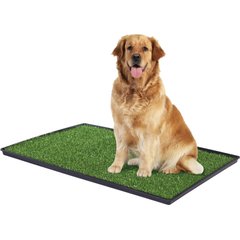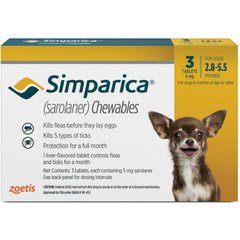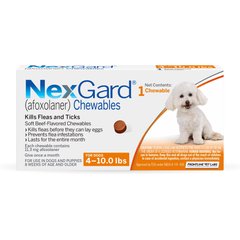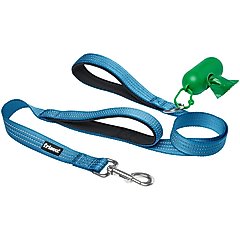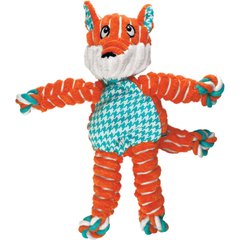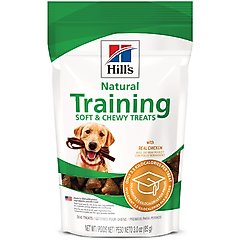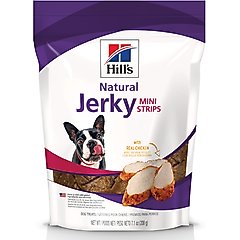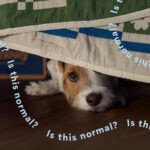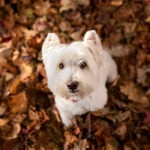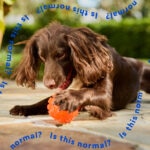Why Do Dogs Roll in the Grass? Is This Normal?
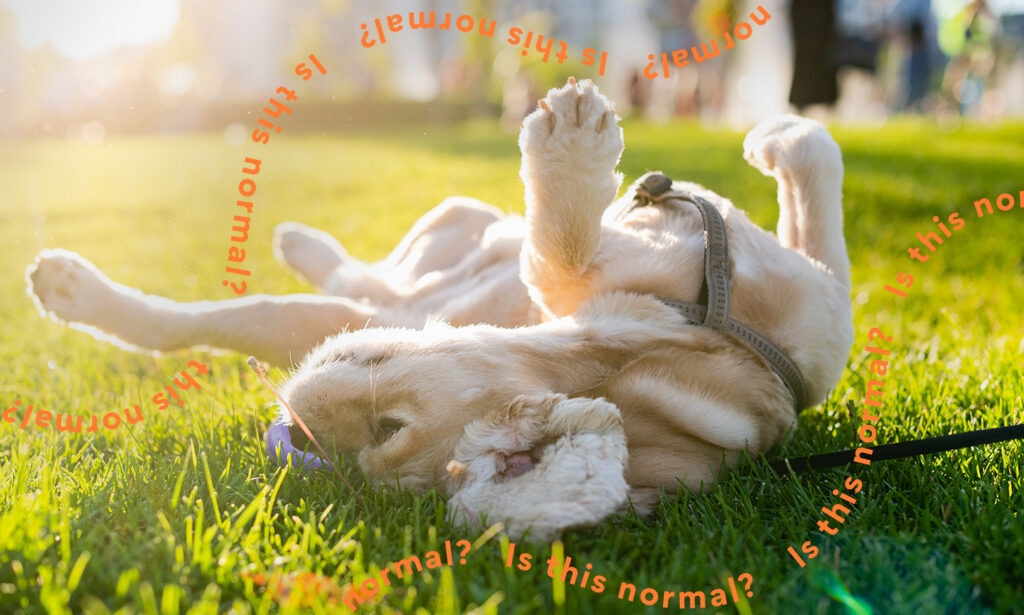
Photo by Getty Images/Chewy
Q: I can always expect my pup to roll in the grass whenever we go outside. He seems to really love his grass-shimmy time, even if it’s a little muddy! Why do dogs roll in the grass? And is it normal?
A: Yes, it’s completely normal for dogs to roll in the grass! Typically, dogs enjoy doing it because it’s fun for them and feels good or they’re marking their scent, among other reasons.
We spoke with a dog trainer and a veterinarian to learn more about this super cute—and sometimes stinky!—behavior.
Why Do Dogs Roll in the Grass?
Does your canine companion find a plush patch of grass to roll on no matter where you go? There are a few explanations as to why they might do this.
Here are some common reasons your dog may roll around in grass.
Scent Masking
Scent masking is when a dog disguises their scent with environmental odors to protect themselves from potential prey or rivals.
Used as a survival tactic by wolf ancestors, dogs might use smelly materials, like grass, manure, or dead worms to mask their own scent.
Communication
If you notice your pooch is having a wag-worthy time when rolling in the grass, they could be trying to share a message with their doggy friends. (We’d like to think that this could be a basic introduction of who they are and their favorite foods.)
“Dogs have scent glands on their bodies that they use to communicate with other dogs,” says Amanda Farah, CPDT-KA, a certified dog trainer and the coordinator of national training and behavior for Best Friends Animal Society based in Kanab, Utah.
“A dog who rolls in the grass may be leaving their own scent behind so other dogs know they were there, or they may be covering the scents of dogs who were there previously,” she adds.
Skin Relief
The texture of grass can provide a lot of comfort to a dog who feels itchy.
Rolling in grass allows them to get those hard-to-reach spots, like along their back and the base of their tail, acting as their personal back scratcher.
“Some dogs have figured out that when they’re itchy, certain surfaces are more satisfying to rub against,” Farah says. “Carpet, sand, and grass are favorites of many dogs.”
If your dog spends a lot of time rolling in grass or rubbing on other surfaces, it’s recommended to consult a vet to rule out potential skin conditions, allergies, or fleas.
Enjoyment
This behavior could simply come down to dogs just loving it—so much so that you can even see them smiling as they roll! After all, we know the smallest things can bring our fun-loving pups the greatest joy (like worn socks and random sticks).
The tactile sensation could feel good, similar to us stretching, says Sabrina Kong, DVM, a veterinarian based in California, and veterinary consultant at WeLoveDoodles.com.
Not to mention, the scent of grass, and scents in the grass, can be fascinating for them to sniff out—and even eat.
You can bring the outdoors in and give your dog a safe place to roll with indoor “grass,” like the Prevue Pet Products turf.
Recommended Product
Play or Modeling
“Like us, dogs are social creatures, so some dogs like to roll when they see other dogs rolling,” Farah says. “Maybe they’re all attracted to the same scent for other reasons, but maybe they’re just jumping on the trend.”
Should I Stop My Dog From Rolling in the Grass?
The short answer? It depends. Generally, rolling in the grass can be safe, seemingly endless fun for dogs. However, there are some cases where it’s best to keep them from doing so for their safety.
When It’s OK To Let Them Roll
Some dogs especially revel in the chance to frolic and roll in the grass. If you notice your happy pup rolling and enjoying themselves, you can definitely let them continue the behavior—just make sure they are on a flea and tick prevention.
Recommended Products
When You Might Want To Stop It
Our experts recommend intervening in your dog rolling in the grass in the following instances:
- If it’s excessive: While rolling in grass is typically harmless, watch for excessive rolling that disrupts daily life or accompanies additional symptoms—specifically skin issues like redness or odor—or stress signals such as panting or whining, Dr. Kong says. Obsessive rolling after walks could indicate allergies or anxiety.
- If there are hazards: Your pup should avoid rolling in the grass if it’s chemically treated with pesticides or fertilizers, mold, or littered with hazards, like sharp debris or parasites, Dr. Kong says.
- If it’s muddy or gross: Muddy grass could get moisture in the ear and that could lead to an ear infection, especially in floppy-eared breeds, and if there are any foxtails in the grass, they can embed in the skin, Dr. Kong says. It’s also a good idea to redirect your dog’s desire to roll in the grass if there’s something foul in it that you’d rather not wear all day, Farah notes. A prime example of this is if your dog tends to roll in poop!
Dr. Kong recommends using a dog leash in risky areas and doing post-roll checks to inspect your dog’s fur, paws, and ears for ticks, foxtails, burrs, or irritation.
Recommended Product
You can protect your dog from external parasites with flea and tick medicine.
How To Redirect the Behavior
If you’d like to stop your dog from rolling in the grass, the quickest way to focus their attention elsewhere is to be more fun and interesting than the grass, Farah says.
She shares these tips on how to redirect your pup’s grass rolling:
- Watch for the telltale signs that your dog is about to roll. It begins with intense sniffing, and then you might see that shoulder start to dip a bit.
- Instantly become the most interesting person at the park. Put on your happy, playful voice, loosen up your own body language, turn your body away, and begin to run slowly in the other direction while using your best “play with me” voice.
- When they follow, reward with a dog toy or dog treats. Leaving behind an area with a scent is a big-deal accomplishment.
Recommended Products
Other training cues that Farah recommends include:
The “Leave It” Cue
This is the best time to use this cue, Farah says.
When doing so, speak in an upbeat, request voice rather than a serious warning tone.
This safe cue should always be something your pup finds fun—not stressful—to keep the cue strong, she explains.
Because scents can be extremely rewarding for a dog, remember to give them grace if it’s difficult for them to resist. Reward them with a high-value treat, like Hill’s Natural Jerky Mini-Strips, if they do it with minimal hesitation.
Recommended Product
The “Let’s Run” Cue
With this cue, simply say, “Let’s run!” to your dog, then turn and take off running.
Farah trains this on a leash during a walk and recommends waiting for your dog to come with you. Alternate giving “run” and “walk” cues for a fun game.
When you need to move away from something quickly, having a dog who knows and loves the “let’s run” cue is valuable, she says.
FAQs About Dogs Rolling in Grass
Q: Why do dogs rub themselves on grass?
A: Dogs can rub themselves on grass for several reasons, ranging from scratching an itch, and because it’s fun or feels good, to masking their scent and communicating with other dogs.
Q: Can rolling in grass be a sign of allergies?
A: Yes, sometimes rolling in grass can be a sign that a dog has allergies—especially if it’s excessive or you notice they roll and rub their body on various surfaces.
Q: Should I let my dog roll in wet or muddy grass?
A: It depends. You can let your dog roll in wet or muddy grass but be mindful of the cleanup involved—as well as potential hazards like pesticides and fertilizers, parasites, and bacteria. It’s also important to note that some dogs can be allergic to grass.
Attributions
This content was medically reviewed by Jo Cornett, DVM, Chewy veterinarian.
